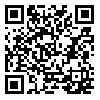Volume 23, Issue 2 (Pajouhan Scientific Journal, Spring, In Press 2025)
Pajouhan Sci J 2025, 23(2): 0-0 |
Back to browse issues page
Research code: 28646
Ethics code: IR.SUMS.SCHEANUT.REC.1402.112
Download citation:
BibTeX | RIS | EndNote | Medlars | ProCite | Reference Manager | RefWorks
Send citation to:



BibTeX | RIS | EndNote | Medlars | ProCite | Reference Manager | RefWorks
Send citation to:
Jafarnezhad A, Ghaem H, Sahraian A, Hassanzadeh J. Scoring and Norming of the Standardized Addiction Tendency Questionnaire for Iranian Children Aged 12 to 18. Pajouhan Sci J 2025; 23 (2)
URL: http://psj.umsha.ac.ir/article-1-1199-en.html
URL: http://psj.umsha.ac.ir/article-1-1199-en.html
1- Student Research Committee, Shiraz University of Medical Sciences, Shiraz, Iran
2- Non-Communicable Diseases Research Center, Department of Epidemiology, School of Health, Shiraz University of Medical Sciences, Shiraz, Iran
3- Research Center for Psychiatry and Behavioral Sciences, Shiraz University of Medical Sciences, Shiraz, Iran
4- Research Centre for Health Sciences, Institute of Health, School of Health, Department of Epidemiology, Shiraz University of Medical Sciences, Shiraz, Iran ,epidhassanzadeh@gmail.com
2- Non-Communicable Diseases Research Center, Department of Epidemiology, School of Health, Shiraz University of Medical Sciences, Shiraz, Iran
3- Research Center for Psychiatry and Behavioral Sciences, Shiraz University of Medical Sciences, Shiraz, Iran
4- Research Centre for Health Sciences, Institute of Health, School of Health, Department of Epidemiology, Shiraz University of Medical Sciences, Shiraz, Iran ,
Abstract: (96 Views)
Background and Objectives: Substance addiction is a significant health and social problem among children, necessitating standardized screening tools. This study aimed at scoring and norming the standardized Addiction Tendency Questionnaire for Iranian children.
Materials and Methods: This cross-sectional and descriptive-analytical study involved 1,532 Iranian students aged 12-18 years. Multi-stage sampling (stratified-cluster-simple random) was employed, and data were collected using a standardized questionnaire. Data analysis was performed using SPSS software (version 22). For normalization, three statistical criteria were utilized (i.e., 95th percentile, Z-score, Mean±2 standard deviations).
Results: Scoring and normalization were conducted based on statistical criteria. The findings revealed that age (OR=1.22, P<0.05), female gender (OR=1.77, P<0.01), secondary education level (OR=1.63, P<0.05), and parents' educational level below diploma (father: OR=2.17, P<0.01; mother: OR=2.35, P<0.01) were significantly associated with increased odds of addiction susceptibility. These results confirm that low parental educational level is the strongest predictor of addiction risk.
Conclusion: This study aimed at scoring and norming the standardized Addiction Tendency Questionnaire for Iranian children. The results demonstrated that statistical criteria (mean±2 standard deviations, Z-score, and 95th percentile) can identify high-risk groups. Therefore, this tool can be introduced as a basis for public health policymaking and prevention, as well as screening programs in schools and healthcare centers. By providing a scientific framework based on demographic and psychometric evidence, this questionnaire enables targeted screening and the development of practical strategies in the field of public health in Iran.
Materials and Methods: This cross-sectional and descriptive-analytical study involved 1,532 Iranian students aged 12-18 years. Multi-stage sampling (stratified-cluster-simple random) was employed, and data were collected using a standardized questionnaire. Data analysis was performed using SPSS software (version 22). For normalization, three statistical criteria were utilized (i.e., 95th percentile, Z-score, Mean±2 standard deviations).
Results: Scoring and normalization were conducted based on statistical criteria. The findings revealed that age (OR=1.22, P<0.05), female gender (OR=1.77, P<0.01), secondary education level (OR=1.63, P<0.05), and parents' educational level below diploma (father: OR=2.17, P<0.01; mother: OR=2.35, P<0.01) were significantly associated with increased odds of addiction susceptibility. These results confirm that low parental educational level is the strongest predictor of addiction risk.
Conclusion: This study aimed at scoring and norming the standardized Addiction Tendency Questionnaire for Iranian children. The results demonstrated that statistical criteria (mean±2 standard deviations, Z-score, and 95th percentile) can identify high-risk groups. Therefore, this tool can be introduced as a basis for public health policymaking and prevention, as well as screening programs in schools and healthcare centers. By providing a scientific framework based on demographic and psychometric evidence, this questionnaire enables targeted screening and the development of practical strategies in the field of public health in Iran.
Type of Study: Research Article |
Subject:
Biostatistic & Epidemiology
Received: 2025/04/20 | Accepted: 2025/06/1 | Published: 2025/06/21
Received: 2025/04/20 | Accepted: 2025/06/1 | Published: 2025/06/21
Send email to the article author
| Rights and permissions | |
 |
This work is licensed under a Creative Commons Attribution-NonCommercial 4.0 International License. |






